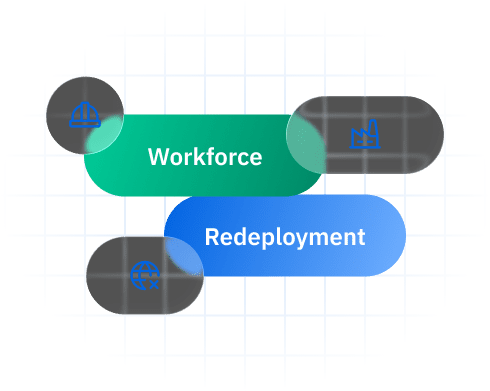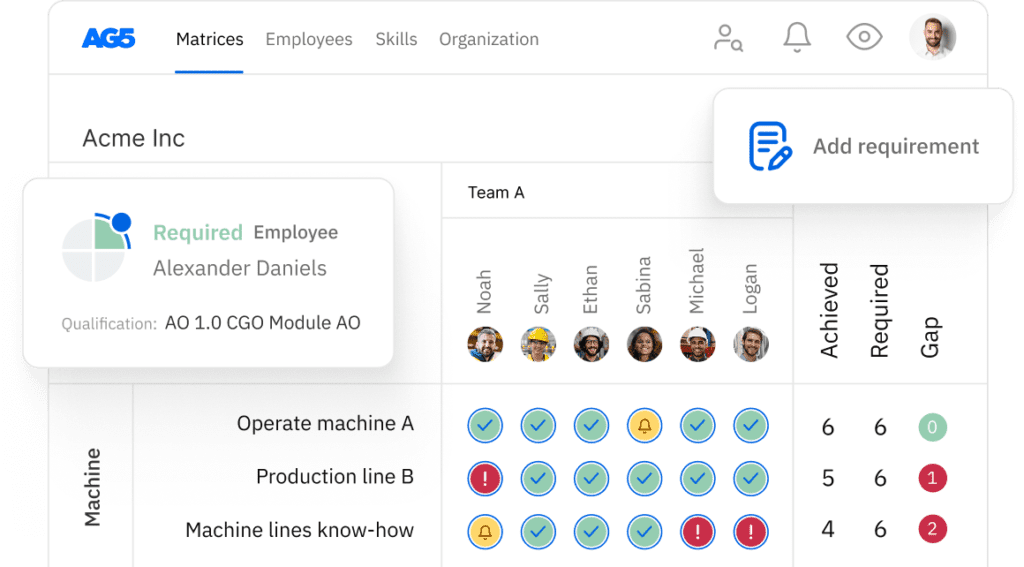Workforce redeployment: Building an agile, future-ready organization
This guide explores why redeployment matters now more than ever, how skills visibility and technology are changing the game, and what steps organizations can take to build a resilient, future-ready workforce.

TL;DR summaryCopied
Workforce redeployment empowers organizations to stay agile and compliant by moving talent to where it’s needed most based on real-time skills data, automated gap analysis, and proactive training.
Using technology, clear processes, and transparent communication, companies can optimize talent, minimize risk, and support ongoing employee development.
What is workforce redeployment?Copied
Workforce redeployment is the strategic movement of employees within an organization to new roles or functions based on evolving business needs, skills requirements, and internal opportunities – ensuring optimal talent utilization, business continuity, and employee growth.
Workforce redeployment is not a fallback plan but a proactive strategy for future readiness. Unlike traditional job transfers or redundancies, redeployment aims to match employees’ existing and potential skills with roles where they deliver the most value.
This approach goes beyond short-term problem-solving, strengthening organizational agility by aligning talent with business priorities as market demands, technologies, or compliance requirements shift.
A well-executed redeployment program benefits both employer and employee. Organizations minimize layoffs, retain valuable institutional knowledge, and avoid costly external hiring.
Employees gain new career development opportunities, enhanced job security, and a clearer sense of contribution. This is especially relevant in regulated sectors where compliance, audit, and certification needs often dictate rapid resource reallocation.
Key aspects:
- Redeployment is data-driven, leveraging tools like skills matrices to make informed decisions
- Focuses on building internal mobility and continuous learning
- Relies on clear processes to ensure transparency and employee engagement
Redeployment vs. redundancy: What’s the difference?Copied
Redeployment reallocates employees to new roles within the organization, while redundancy is the process of terminating positions that are no longer required, according to Ashman [1].
The terms redeployment and redundancy are sometimes confused, but their impact on organizations and employees is fundamentally different. Redundancy is often a last-resort measure, used when roles are eliminated due to downsizing, restructuring, or automation.
It carries significant costs – not only financial, but also the loss of experience and morale among remaining teams.
Redeployment, by contrast, is a forward-looking strategy. Rather than parting ways with capable talent, organizations identify transferable skills and move employees into roles where they can add immediate value.
This approach mitigates disruption, preserves critical know-how, and demonstrates a commitment to internal development. For regulated industries, redeployment also maintains compliance by ensuring all necessary skills and certifications remain in-house.
A successful redeployment program requires clear visibility into workforce capabilities, proactive communication, and systems that track skills, training, and certifications across the business.
| Factor | Redeployment | Redundancy |
|---|---|---|
| Employee outcome | Retained, new role | Job loss |
| Business benefit | Talent retention, agility | Cost-cutting, risk |
| Compliance impact | Skills maintained | Potential skills gaps |
| Employee sentiment | Engaged, growth-minded | Disengaged, uncertain |
Why workforce redeployment matters todayCopied
Workforce redeployment is essential for organizations facing market volatility, shifting regulatory requirements, and the growing need for agile, future-ready teams, enabling businesses to adapt quickly, remain compliant, and support employee growth.
The Paycor report [2] highlights that 79% of employees value flexible work options, which supports redeployment strategies for creating future-ready teams in volatile markets.
The pace of change in today’s business environment is relentless, driven by new technologies, evolving customer demands, and regulatory updates. Organizations can no longer afford static workforce models.
Redeployment delivers resilience, giving companies the ability to match talent to business priorities without the lag and expense of external hiring. This is particularly vital for regulated industries, where a sudden change in compliance standards can expose gaps in certifications or required skills.
Internal mobility also drives engagement. Employees who see pathways for career development and lateral movement are more likely to stay, reducing costly turnover. Redeployment keeps institutional knowledge in-house and empowers learning and development (L&D) teams to align training with real, time-sensitive needs.
Highlights:
- Mitigates risks from market shifts or project pivots
- Supports business continuity in compliance-driven sectors
- Reduces layoffs, improving morale and employer brand
- Enables real-time alignment of talent and business strategy
How skills visibility powers successful redeploymentCopied
Skills visibility, knowing exactly who can do what, and where gaps exist, is the foundation of effective workforce redeployment and organizational agility.
Redeployment decisions are only as strong as the underlying data. Traditional methods – like spreadsheets or fragmented records – cannot provide a live, accurate picture of workforce capabilities. By adopting skills management software and digital skills matrices, organizations build a centralized, real-time view of current proficiencies, certifications, and gaps.
With this foundation, HR, L&D, and operations leaders can quickly assess which employees are eligible and qualified for open roles or urgent projects.
This is crucial during audits, compliance reviews, or business pivots. Automated alerts for expiring certificates and tailored skills dashboards make redeployment a continuous, proactive process.
| Challenge | Solution | AG5 Advantage |
|---|---|---|
| Outdated spreadsheets | Real-time digital skills matrices | Fewer manual errors |
| Hidden expertise | Searchable skills database | Faster talent matching |
| Certification gaps | Automated expiry alerts | Audit-ready compliance |
Identifying and closing critical skills gapsCopied
Accurate identification of skills gaps allows organizations to redeploy employees where they’re needed most, and to target upskilling for future readiness.
Successful redeployment starts with understanding the gap between current and required skills. A digital skills matrix allows you to map every employee’s proficiencies against business needs, highlighting shortages and over-supplied skills.
This transparency helps managers plan targeted upskilling, reallocate staff efficiently, and avoid compliance lapses that can derail projects or audits.
With AG5, skills gap analysis becomes an automated process – flagging missing competencies, generating reports for management, and even suggesting relevant training options. Instead of discovering issues during an audit or critical project, you stay ahead, redeploying talent and closing gaps before they impact performance.
Bullets for implementation:
- Conduct regular skills assessments using live data
- Set up gap alerts to trigger redeployment actions
- Link skill gaps to specific training initiatives
- Track progress continuously, not just annually
Do compliance and audit requirements impact redeployment?Copied
Yes. Compliance and audit requirements shape redeployment by demanding that only qualified, certified staff fill regulated roles, making skills and certification tracking critical.
Redeployment must account for industry regulations, safety standards, and audit protocols.
Many sectors such as healthcare, manufacturing, and energy require proof of certification, ongoing training, and adherence to strict frameworks. Missteps can result in fines, project delays, or reputational damage.
A robust skills tracking system ensures that every redeployment decision is audit-ready. Automated certificate management, expiry notifications, and digital audit logs replace cumbersome manual processes, so you can demonstrate compliance at any time.
AG5 supports approval workflows, documentation, and integration with HRIS/LMS tools, ensuring that only appropriately certified personnel are assigned to sensitive roles.
| Requirement | Digital solution | Redeployment benefit |
|---|---|---|
| Proof of qualification | Certificate vault, e-signature | Avoid compliance gaps |
| Expiry tracking | Automated alerts | No last-minute scrambles |
| Audit trails | Digital reporting | Faster audit clearance |
How to align training with redeployment needsCopied
Aligning training with redeployment means connecting identified skills gaps to relevant learning opportunities, ensuring employees are prepared for new roles, and compliance is maintained.
Once gaps are clear, the next step is actionable: map those gaps directly to training and development pathways.
This alignment is critical for redeployment, as it accelerates readiness and reduces downtime. AG5’s software links skill requirements to courses, tracks completion, and automates reminders, removing manual bottlenecks for L&D teams.
This approach makes it easy to update training as business needs change, track progress across teams, and report on compliance instantly. It also supports internal mobility by giving employees a transparent roadmap for advancement and new opportunities. The result: faster, smarter redeployment, higher morale, and fewer compliance failures.
Successful alignment:
- Link every skills gap to a learning resource or course
- Use automated tracking to monitor completion and impact
- Provide employees with visibility into their progress
- Regularly review and update training plans as priorities evolve
Why technology is key to redeployment efficiencyCopied
Modern workforce redeployment relies on technology, specifically, skills management software to centralize data, automate processes, and support rapid, compliant talent shifts.
Manual tracking is a recipe for missed opportunities and compliance risks. Technology transforms redeployment from a reactive exercise to a proactive, strategic capability.
With integrated skills management software, organizations gain real-time visibility into skills, certifications, and availability – across every department and location.
Integration with HRIS and LMS platforms means data is always up-to-date, and deployment workflows can be automated. This ensures that every redeployment decision is made on the basis of current, accurate data, minimizing errors and administrative overhead.
Features such as expert-finder tools, mobile self-assessment, and digital audit logs further streamline operations and support business continuity.
Table: Technology-enabled redeployment
| Function | Manual process | Technology-enabled |
|---|---|---|
| Skills inventory | Spreadsheets | Digital, real-time |
| Certification check | Manual lookup | Automated alerts |
| Gap analysis | Annual review | Continuous monitoring |
| Audit reporting | Paper records | Export-ready dashboards |
How to build an effective workforce redeployment strategyCopied
An effective redeployment strategy is structured, data-driven, and employee-centered. It is built on transparent processes, proactive skills tracking, and continuous feedback.
Redeployment success requires clear workflows and organizational buy-in. Start with a current skills inventory, then use data to guide every step, from gap analysis to targeted upskilling.
Communicate openly with employees, involve them in self-assessment, and use feedback to refine processes. Technology should support and not replace human judgment, making it easy for managers to match talent to evolving needs while maintaining compliance and engagement.
Step-by-step framework:
- Audit existing skills. Build a comprehensive, up-to-date inventory
- Analyze gaps. Identify shortages by comparing needs vs. current state
- Engage employees. Use self and manager assessments for transparency
- Target training. Map gaps to courses and track progress
- Automate workflows. Integrate software to support real-time decisions
- Communicate regularly. Keep employees informed and involved
- Monitor and adjust. Use analytics to measure success and refine approach
FAQs Copied
-
What is workforce redeployment?
-
How does redeployment benefit organizations?
-
Is redeployment only for large enterprises?
-
How is redeployment different from redundancy?
-
How do you identify who should be redeployed?
-
What role does training play?
-
How do you ensure compliance during redeployment?
-
What technologies support redeployment?
Sources Copied
- Change view: Table
-
APA
| # | Source title | Description | Publication | Retrieved | Source URL |
|---|---|---|---|---|---|
| 1 | Downsizing: Managing Redundancy and Restructuring | SpringerNature | May 28, 2016 | August 14, 2025 | https://link.springer.com/chap.. |
| 2 | HR Statistics You Need to Know for 2025 | Paycor | October 11, 2024 | September 1, 2025 | https://www.paycor.com/resourc.. |
Author Copied
Revisions Copied
Written by: Rick van Echtelt
Copy edited by: Adam Kohut

